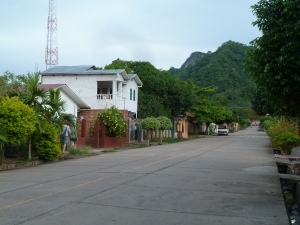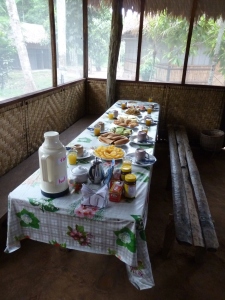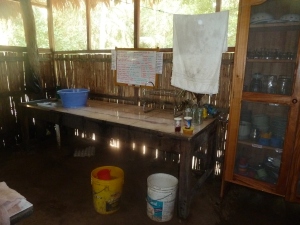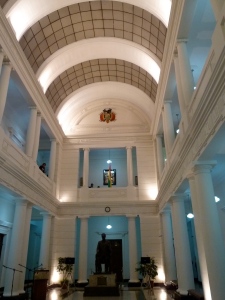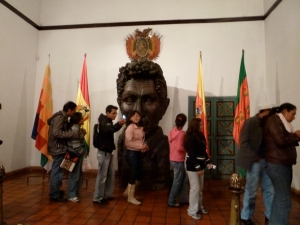So once I realised I wouldn´t be leaving South America until the end of January 2012 I decided to spend an extra month in Bolivia and contacted Mashaquipe to see if I could go back there as a volunteer for a month. I knew I didn´t want to work with animals (there are several animal sanctuaries in Bolivia where you can work with pumas and other animals) nor did I think I was up to working with orphans or street children (there are also many opportunities to do this in Bolivia). I couldn´t imagine a place more different from my life in London and I also wanted to better understand the Bolivian culture in this part of the country after spending most of my time in the Andes regions of Peru and Bolivia. Fortunately they said yes so I decided to take the bus back to La Paz and then a flight to Rurre (I still didn´t fancy the long and dangerous bus ride…).
I had a couple of days in Rurre to organise things and this turned out to be a great couple of days. When I arrived in Rurre Los Tucanes said they didn´t have any rooms available (they always seemed to say this to solo travellers arriving before the last plane) but that there was a girl who wanted to share a room, which was even better (cheaper and some company). Theres from Switzerland (doing her masters geography thesis in a village called Palmar) couldn´t have been a better room-mate! I had a fun couple of days and nights hanging out with her and three volunteers from Madidi Travel (another jungle tour agency in Rurre) – eating good food, going to the outdoor cinema (to watch a terrible film) and drinking cocktails and playing table football in Moskkito Bar. As they were soon to be leaving Madidi Travel they tried to talk me into volunteering there but I was more keen to spend time volunteering in the jungle itself rather than in Rurre.
I also fitted in getting my washing done (as I would be hand washing my clothes for the next month), sending last emails and Facebook updates as I would not have email or phone access, and buying bug spray and batteries.
I also got my hair cut. I`d joked with my hairdresser in London before I left that I wanted it cut short so that I wouldn`t need to go to the hairdressers in Bolivia. Well at least it was an interesting experience that didn`t cost me a lot of money. For 1.50 pounds I had my hair cut with what I can only describe as the type of scissors they give to kids in school for cutting paper. Big blunt chops of hair were removed and at least only where I`d asked her to cut it. To be fair, she cut exactly what I asked and even trimmed up my hairline with a razor for me. There was no wash or blow dry to go with the cut. It looked ok and at least it would stay short enough for the next month not to annoy me in the heat.
So the day I was supposed to go to the Mashaquipe lodge the boat went in the morning rather than in the afternoon, so I tried again the next day and had more luck. I took the boat up the river with some fun and enthusiastic Canadian guys and their guide, Nicolas.
On arrival it wasn´t entirely clear what my tasks or schedule would be during my stay but I was quickly pointed in the direction of Maribel (Mari) who was in charge of cleaning, making beds and general administration of the lodge, and she introduced me to the two cooks, Elly and Gina. As I am terrible with names I had to write down everyone´s names as I met them, otherwise I would forget!
Over the next few days I started to get into the rhythm of the lodge and get to know the people working there. Going to bed early (about 9.30pm) and getting up early (about 6am) seemed to be the pattern and afternoon siestas were encouraged when it wasn´t so busy. In fact, I was so not used to the slower pace that they had to tell me to go and relax. Seems my London work ethic was still with me after all. I had to explain that I wasn´t used to taking rests during the day and that in the UK, in offices at least, people tend to work long days and even take lunch at their desks. This was met with a certain amount of disbelief and on a few occasions Elly would tell this to other people as they joked about me working too hard!
My main tasks consisted of washing up after breakfast, lunch and dinner, helping clean the cabins and toilets, making beds, raking leaves, helping wash the sheets, cleaning the dining room and setting the table, making juice and refrescos (soft drinks, like squash), teaching English to anyone that was vaguely interested, and resting in hammocks. Given how much I enjoy my job at the V&A (and how unique it is) I´d often wondered what it might be like to do a more ‘regular’ job. I´m sure the relaxed jungle setting with no stress and lovely people helped but it did make me realise that I could do all sorts of different work if I put my mind to it.
Unfortunately, I started the day after a French girl left as a volunteer but was soon joined by a lovely Canadian couple called Norm and Lauren. I think Norm might have been one of only a few male volunteers they´ve had at Mashaquipe. This also highlighted the more traditional roles that are kept in Bolivian (and more generally, South American) society. I was allocated to help in the kitchen (I`d obviously dazzled them with my washing up skills) and Lauren was allocated to help Mari with making beds, cleaning and raking. Meanwhile Norm was allocated to help John with boat stuff and Inato with cutting stuff with machetes (mainly tidying the grounds or clearing new areas for future construction).
